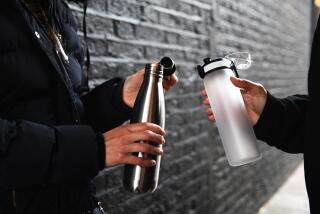Doctors Urged to Quit Fishing for Kidney Stones
- Share via
Most small kidney stones can be safely treated by allowing them to pass naturally through the body rather than resorting to surgery, according to new guidelines issued by the American Urological Assn.
An expert panel also recommended halting the practice of “blind basket” extraction, a therapy that is still sometimes used to remove small stones and can damage the tubes leading from the kidney to the bladder.
The guidelines, which will be published in the Journal of Urology in November, offer for the first time clear procedures for treating kidney stones based on their size.
“The urological community will benefit from them,” said Fredric Coe, professor at the University of Chicago and director of its kidney disease program.
For unknown reasons, the incidence of kidney stones has been rising in the United States in the last two decades. Roughly 10% of Americans will develop a kidney stone during their lifetime, according to the National Institute of Diabetes, Digestive and Kidney Diseases, part of the National Institutes of Health.
Once someone has suffered one kidney stone, the likelihood of having more escalates sharply. The stones often produce agonizing pain. They are most common in people age 20 to 40, are about twice as likely to strike men as women and are more frequently found in whites than in blacks.
The stones begin when compounds in the urine form crystals inside the kidneys. About 75% of kidney stones are made up of calcium oxalate. Up to 20% of stones are composed of struvite or magnesium ammonium phosphate. The remainder are a combination of uric acid, calcium phosphate and cystine. The stones range from the size of a grain of sand up to golf-ball size.
Some stones cause no pain and generally do not create any problems. They can remain there indefinitely.
But when they begin moving down the ureters--the tubes that connect the kidneys to the bladder--the pain can be excruciating.
Treatment begins with strong pain relievers. Patients in the most acute pain are usually hospitalized and given intravenous morphine.
The guidelines say 98% of stones half a centimeter or less in diameter will eventually spontaneously pass through the ureter. In such cases, patients should drink copious amounts of water and may need powerful painkillers.
The practice of threading a small instrument shaped like a basket through the urethra and bladder to the ureter to extract the stone without the advantage of any imaging guidance should be stopped, the Urological Assn. panel said. This technique can damage the ureters and may leave remnants of the stone behind, panel members noted.
While there are no national statistics available on how often this therapy is used, health experts believe it is still quite common.
Coe and his colleagues at the University of Chicago studied 2,500 people who had been originally treated for kidney stones by physicians in other hospitals. They found that blind basketing accounted for about 10% of patients treated in 1990 and about 5% in 1995.
“Blind basketing the old way is less safe [than other techniques available today],” said Joseph Segura, chairman of the Urological Assn.’s seven-member guidelines panel and professor of urology at the Mayo Clinic in Rochester, Minn. “We’re really saying to physicians, if you’re still doing blind basketing, you really shouldn’t.”
The panel also recommended that a treatment called extracorporeal shock-wave lithotripsy should be the first choice for slightly larger stones, those up to one centimeter in diameter and lodged closest to the kidney. Lithotripsy is a noninvasive outpatient procedure that involves pulverizing stones with shock waves. The remnants of the stones then pass through the bladder and are removed in the urine.
Either lithotripsy or another procedure called uretoscopy could also be used safely to break up stones one centimeter in diameter or smaller that are caught closer to the bladder, according to the guidelines.
Uretoscopy involves threading a small fiber-optic instrument through the urethra, bladder and the ureters. Doctors monitor its progress on a TV screen or by fluoroscopy, an X-ray procedure that displays the picture. Once they reach the stone, it can be caught in a basket and removed or broken up with a laser.
Use of either procedure “is an option,” Segura said.
The advantage of lithotripsy is that it is less invasive, although it still requires some anesthesia.
“We don’t have to stick anything in you to get it done,” Segura said. The drawback is that “it’s less successful as a onetime treatment.”
About 20% to 30% of lithotripsy fails to clear the stone on the first try. That means either a repeat procedure or trying another therapy, which adds to the cost and the potential for complications.
The benefit of uretoscopy, the panel found, is that it has a 97% success rate “and in some studies 100%,” Segura said. “When you’re done with the procedure, you’re done, but the disadvantage is that it does require an anesthetic” and surgical equipment.
The current practice of reserving surgery for only the largest stones should be continued, the panel said.
Why some people develop kidney stones and others do not is not known. Gout, use of calcium-based antacids and excessive consumption of vitamin D may increase the risk.
Diet may also play a role. But it seems that people first must have a susceptibility to form stones. Foods rich in calcium and oxalate--dairy products, berries, cola drinks, coffee and spinach--are considered likely culprits.
But two Harvard University studies found that a diet high in calcium-rich foods actually lowered the risk of kidney stones, while use of calcium supplements raised the risk.




